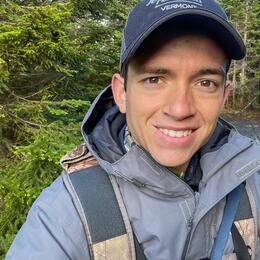Shortly after graduating from the University of Vermont in 2022 with a degree in Wildlife Biology, I began my first job out of undergrad as a Forest Conservation Intern with Audubon Vermont. My responsibilities included conducting breeding bird surveys at forestry demonstration sites, assessing forest bird habitat on private lands around the state, and conducting baseline surveys for sugarbushes being enrolled in the Bird-friendly Maple Project. By the end of the summer, I knew the ins and outs of a healthy and bird-friendly forest structure and was well familiarized with the various silvicultural prescriptions that enhanced these features within Vermont’s exceptionally diverse forests. I may have been an intern who was eager to learn and receive mentorship, but by the end of my position, I had written over 6 forest bird habitat assessment reports that offered landowners valuable insights into how to best manage their properties for bird diversity and forest resiliency. By the end of my position, I had made countless connections with landowners, forestry professionals, and forest organizations from around the state and I even had the opportunity to co-lead a few outreach events and forest walks! Overall, I would rate my experience as a Forest Conservation Intern a solid 10/10!
With connections already being established among the Audubon Vermont network, I decided to apply to be the Community Science and Chapter Engagement AmeriCorps member at Audubon Vermont that fall. When I received word that I had gotten the position, I was ecstatic, not only for the service experience that lay ahead of me, but also for the opportunity to remain on staff at Audubon Vermont. Leaving direct conservation efforts and moving on to serve as an environmental educator was a bit of a shock at first. Having little experience educating children, the first few weeks as an educator were a steep learning curve, and I was very thankful to have the support and mentorship of other integral members of the education team throughout my service term. I am very thankful for my experiences educating young children through my AmeriCorps position as there is something truly wonderful about the curiosity, energy, spontaneity, and joy exhibited by children. At the end of a day filled with teaching a field trip or leading a day of vacation camp, I would be exhausted, but it was always a rewarding and humbling experience. It sounds cliché, but I would often wonder if I was learning just as much from the kids as I was teaching them.
Anyone who knows me also knows that I have a deep-rooted passion for and fascination with birds and many other aspects of the natural world. Throughout my service, I found opportunities for this passion to shine through and in every opportunity to teach others about community science, point out a bird to a group in the field, or share a random awe-inspiring bird fact with someone, I found immense joy. Although the true impacts of many of these moments are largely unknown, the thought of my actions and my service having an impact on someone’s life for the better of birds, wildlife, and nature is truly powerful, inspiring, and a motivator for me through the service year. Perhaps one of my favorite moments was bumping into a family traveling along the Bailey Trail through the Beaver Pond wash area whilst I was updating signage for the Nature’s Notebook Phenology Walk. It was a hot July afternoon with a surprising amount of bird activity, and I had been sidetracked by a sweet melodious song. One lady asked me what bird was singing and I explained that it was a rose-breasted grosbeak, narrowly concealed among the wispy outer branches of a hemlock tree. As I began to explain the differences between the grosbeak song and that of a robin, the gentleman standing next to the lady inquired about a bird flying high in the sky. Using my binoculars, I locked in on a large raptor soaring effortlessly on flat, broad wings speckled with messy splotches of white on an otherwise dark brown background, it was an immature bald eagle! As the eagle swooped low and flew directly overhead, the rest of the family group arrived on scene and was alerted of the presence of this spectacular bird that was now rising in tight circles on a thermal shared by two turkey vultures. Seconds later, a Broad-winged Hawk appeared low over the treetops, flying overhead before circling around the beaver pond. I was overwhelmed with excitement of the raptor spectacle we were observing, and that excitement seemingly spilled over to the other spectators, including a young boy. Following that interaction, I was left with the hope that those people found some form of happiness, awe, or wonder in the splendor of the natural world. There are so many amazing things happening in nature all around us and I love opening people’s eyes to these spectacular events that always keep me living life in the moment, escaping everyday stresses, and finding joy in a world and ecosystem so much larger and more complex than my human life.
While I am saddened to be leaving the amazingly kind and talented staff of Audubon Vermont behind, I am excited for my next steps! I am moving across the country to continue pursuing a career in bird and forest conservation as a Bioacoustics Laboratory Fellow with the Oak Ridge Institute of Science and Education and the US Forest Service. In this position, I will be working to create and train a computer model that will effectively identify key bird species vocalizing in millions of hours of audio recorded by remote audio recording units dispersed around national forests throughout much of the Pacific Northwest. I am hoping to use this experience as a steppingstone to a graduate program examining how forest management impacts bird species diversity.








